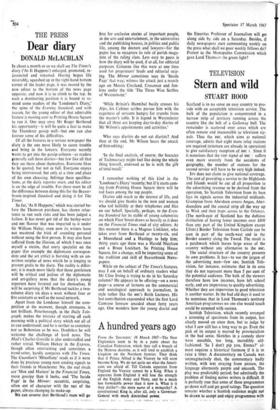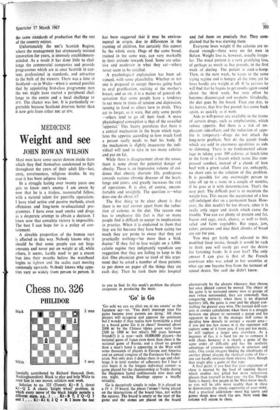Stern and wild
TELEVISION STUART HOOD
Scotland is in no sense an easy country to pro- vide with an acceptable television service. The bulk of the population is concentrated in a narrow strip of territory running across the country like the belt of a Galloway bull. The remainder is scattered over areas which are often remote and inaccessible to television sig- nals. Thus the Bac, which aims at national coverage, admits that eight more relay stations are required (nineteen are already in operation) to give satisfactory reception of BBC I. Since it is notorious that the UHF signal of BBC 2 suffers even more severely from the accidents of geography, the number of stations for the second service will have to be very high indeed.
ITV does not claim to give national coverage. The cost of providing a service to the Highlands and Islands would be out of all proportion to the advertising revenue to be derived from the operation. So Scottish Television from its base lays its signals across the industrial midlands. Grampian from Aberdeen covers Angus, Aber- deenshire and the coastal strip all the way up to Wick and then leaps across to the Orkneys. (The north-east of Scotland has the dubious distinction of having fewer incomes over /800 than any part of the United Kingdom except Ulster.) Border Television from Carlisle can be seen in part of the south-west and in the Border country along the Tweed. The result is a patchwork which leaves large areas of the country without any alternative to the BBC.
The social structure of the country presents its own problems. It has—to use the jargon of the advertising men—few ABS; Scottish Tele- vision, for instance, estimates that in its area they do not represent more than 5 per cent of the potential audience. The bulk of the viewers therefore have low incomes, have left school early, and are impervious to quality advertising. Whether they are impervious to good television is another matter. In the bad old days it used to be notorious that in Lord Thomson's territory American programmes no one else would touch could be screened with success.
Scottish Television, which recently arranged a screening of specimens from its. output, has clearly moved on since then, but to judge by what I saw still has a long way to go. Even the pick of its output is marred by provincialism in the bad sense. Sketches in a comedy show were unsubtle, too long, incredibly old- fashioned. `So I don't pip you, Emma?' al- most requires a historical footnote if it is to raise a titter. A documentary on Canada was unimaginatively shot, the commentary badly written, with text straying from picture, the language alternately purple and uncouth. The play was predictably period; but admittedly the problem of finding native writers is difficult. It is perfectly true that some of these programmes go down well and get good ratings. The question remains whether a Scottish audience might not be drawn to accept and enjoy programmes with
the same standards of production that the rest of the country enjoys.
Unfortunately the BBC's Scottish Region, where the management has strenuously resisted innovation for years, is intensely establishment- minded. As a result it has done little to chal- lenge the commercial companies and provide programmes which are at once Scottish in con- tent, professional in standards, and attractive to the bulk of the viewers. There was a time in Scotland—as in Wales—when it seemed possible that by appointing first-class programme men the BBC might have started a peripheral chal- lenge to the centre and a local challenge to rrv. The chance was lost. It is particularly re- grettable because Scotland deserves better than it now gets from either BBC or ITV.































 Previous page
Previous page